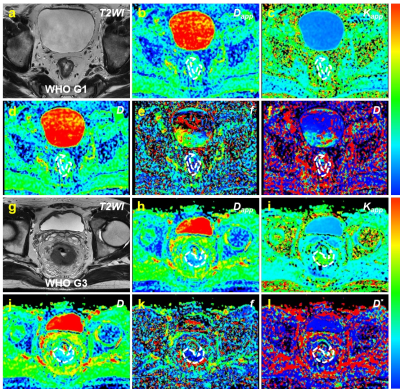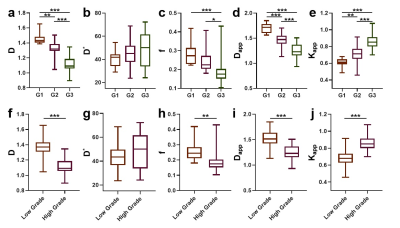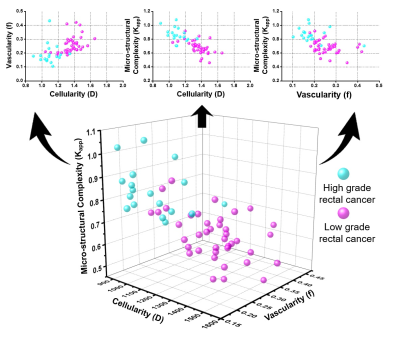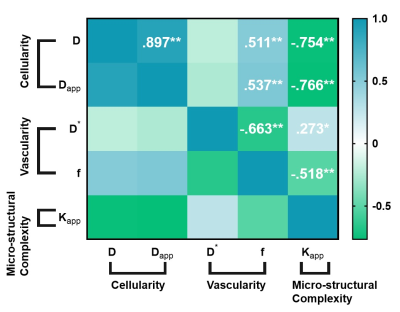4766
Combine the different DWI biological inspirations including cellularity, vascularity and structural complexity to grade rectal cancer1Sun Yat-sen University Cancer Center, Guangzhou, China, 2United Imaging Healthcare, Shanghai, China
Synopsis
Biological inspirations such as cellularity, vascularity and micro-structural complexity of diffusion weighted imaging (DWI) are of great significance during clinical practice. However, scarcely has the systematic integration of these biological inspirations been applied for clinical application. This research aims to systematically integrate cellularity, vascularity and micro-structural complexity derived from diffusion kurtosis imaging (DKI) and Intravoxel Incoherent Motions (IVIM) Imaging, explore their correlations and evaluate their diagnostic performance for grading rectal cancer. Results suggested that the integration of different DWI biological inspirations provided a more comprehensive characterization of tumor, holding great potential during clinical practice.
Introduction
Rectal cancer, one of the commonest human malignancy, accounts for more than 30% of the colorectal cancer with notoriously high fatality rate. Accurate knowledge of histopathological grade of rectal cancer is of great importance for prognosis.1-3 DWI has proven to be a powerful tool for diagnosis, therapeutic effect evaluation and so on. Moreover, numerous DWI models have been established during the past few decades with various biological inspirations.4 Nevertheless, biological inspirations derived from DWI abbreviated as DWI inspirations are nothing more than cellularity, vascularity and micro-structural complexity.4 Additionally, the combinations of different DWI models have been performed in a great deal of researches. However, the most common case is to achieve the diagnostic purpose via comparing the DWI parameter representing the single DWI inspiration between negative and positive group. Scarcely have the systematic integration of different DWI inspirations, the comprehensive exploration of the correlation between all diffusion inspirations and the complete comparison of the diagnostic performance between different DWI inspirations and their combinations been reported.Introducing the DKI and IVIM able to provide all DWI inspirations including cellularity (D derived from IVIM, Dapp derived from DKI), vascularity (f derived from IVIM) and micro-structural complexity (Kapp derived from DKI), this study aims to systematically integrate different DWI inspirations, explore the correlations between all DWI inspirations and compare the diagnostic performance of different DWI inspirations and their combinations for grading rectal cancer. To the best of our knowledge, the combination of DKI and IVIM has hardly been carried out for evaluating the malignancy degree of rectal cancer. Most importantly, hardly have the systematic integration and exploration of all DWI inspirations been reported.
Methods
A total number of 69 patients were recruited. MR measurements were performed on a 3-T MR scanner (uMR 780, United Imaging Healthcare Co Ltd). Detailed MR protocols include T2WI sequence and DWI sequence. The detailed parameters of DWI sequence are as followings: TR/TE/FA:4600 ms/86.2 ms/90°; Matrix/FOV: 168×224/180×240 mm2; In total, 11 b values were applied including 0, 10, 20, 30, 50, 80, 100, 150, 200, 400, 600, 800, 1500 and 2000 s/mm2; Parametric maps were calculated with the previously reported fitting model and different combinations of b values (0, 10, 20, 30, 50, 80, 100, 150, 200, 400, 600, 800 s/mm2 for IVIM, 0, 800, 1500, 2000 s/mm2 for DKI).5,6 The Pearson correlation test was performed to access the correlation coefficients abbreviated as r between the parameters. Binary logistic regression analysis was performed to establish the diagnostic model with the combination of different inspirations. The ROC (receiver operating characteristic curve) analysis was performed to evaluate the diagnostic performance.Results
Representative MR images of WHO G1 rectal cancer and WHO G3 rectal patients were displayed in Fig. 1. Grading rectal cancer in 1D Scale (Single DWI inspiration): On a 1D scale, nearly all quantitative parameters except D* showed the capability of discriminating the rectal patients of different grades with significant difference (p < 0.05). Grading rectal cancer in 2D & 3D scale (Different combinations of DWI inspirations): The Fig. 2 showed that 2D and 3D data spaces were constructed by the combination of different DWI inspirations. Obviously, the high grade patients were better separated from low grade patients in 3D space when cellularity (D), vascularity (f) and micro-structural complexity (Kapp) were simultaneously integrated with small data overlap (Fig. 3). The odds ratio of micro-structural complexity was 3.440, indicating when Kapp increased by one standard unit, the probability of suffering from high-grade rectal cancer was as 3.440 times high as before. The odds ratio of cellularity was 9.350, indicating when D decreased by one standard unit, the probability of suffering from high-grade rectal cancer was as 9.350 times high as before. All diffusion inspirations were significantly correlated with one another (Fig. 4). In addition, the integration of three diffusion inspirations yielded the best diagnostic performance (AUC = 0.953) followed by D & Kapp (AUC = 0.951), D & f (AUC = 0.946), D (AUC = 0.942) and so on. (Fig. 5).Discussion
Aforementioned results indicated that the integration of three DWI biological inspirations can yield fascinating diagnostic performance. The main causes were as the followings: the more the DWI inspirations, the more comprehensive the characterization of rectal cancer, which ultimately resulted in the better diagnostic performance. The result: D is most sensitive for predicting high grade rectal cancer may be explained by following points: the cellularity variation is most pronounced of cellularity, vascularity and micro-structural complexity. As expected, there existed significant correlation between cellularity, vascularity and micro-structural complexity, which further proved the necessity of integrating these inspirations together for obtaining a more comprehensive characterization of tumor.Conclusion
In conclusion, this research indicates greater diagnostic performance can be achieved through integrating the cellularity, vascularity and micro-structural complexity quantified by parameters sourced from DKI and IVIM. Furthermore, because there is a tight correlation among all diffusion inspirations, as results suggests, the integration of different biological inspirations of DWI can provide a more comprehensive characterization of tumor, which holds great potential in many other clinical applications including cancer treatment evaluation, tumor detection, tumor recurrence prediction and so on.Acknowledgements
No acknowledgementsReferences
1. Zhu L, Pan Z, Ma Q, et al. Diffusion Kurtosis Imaging Study of Rectal Adenocarcinoma Associated with Histopathologic Prognostic Factors: Preliminary Findings. Radiology 2017;284(1):66-76.
2. Surov A, Meyer HJ, Hohn AK, et al. Correlations between intravoxel incoherent motion (IVIM) parameters and histological findings in rectal cancer: preliminary results. Oncotarget 2017;8(13):21974-21983.
3. Liang CY, Chen MD, Zhao XX, Yan CG, Mei YJ, Xu YK. Multiple mathematical models of diffusion-weighted magnetic resonance imaging combined with prognostic factors for assessing the response to neoadjuvant chemotherapy and radiation therapy in locally advanced rectal cancer. Eur J Radiol 2019;110:249-255.
4. Tang L, Zhou XJ. Diffusion MRI of cancer: From low to high b-values. JMRI 2019;49(1):23-40.
5. Cui Y, Yang X, Du X, Zhuo Z, Xin L, Cheng X. Whole-tumour diffusion kurtosis MR imaging histogram analysis of rectal adenocarcinoma: Correlation with clinical pathologic prognostic factors. Eur Radiol 2018;28(4):1485-1494.
6. Xu Y, Xu Q, Sun H, Liu T, Shi K, Wang W. Could IVIM and ADC help in predicting the KRAS status in patients with rectal cancer? Eur Radiol 2018(7);28:3059-3065.
Figures




